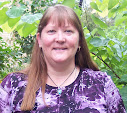 Did you know that honeycomb and soap bubbles have a lot in common?
Did you know that honeycomb and soap bubbles have a lot in common?Well, they do.
Can you see the photo of a single soap bubble on my hand? Do you see that the bubble is round?
When soap bubbles are on their own, they're round.
You can try this experiment yourself to see if it's correct.
All you need is some soap (and Mom will be very glad to know you've washed your hands).
Now watch what happens to the single bubble once it touches other bubbles.
The sides of the soap bubble become slanted and it changes to a honeycomb shape as soon as it touches other bubbles.
Did you know that honey bees make their honeycombs like a soap bubble?
Did you know that honey bees make their honeycombs like a soap bubble?
But if I asked you to draw honeycomb you would draw it with six sides - in a shape called a hexagon.
Beeswax combs end up with six sides after the bees build them but they all start off round.
Yes, round. Like a single soap bubble.
Each honeycomb cell touches another cell.
They'll warm them up to between 37 and 40 degrees Celsius.
Once the combs are warmed, they'll shift into a six sided hexagon shape because of the tension created by the walls touching each other.
Here's some newly made round combs that you can see.
When you count the sides, you'll find there are six--a lovely hexagon.
Below are some more photos of frames I'm holding up.
Are you wondering why the combs in the photo below are brown coloured and why the combs in the photos at the top are white?
There is an answer.
New combs are clean and fresh and look white.
But after thousands of bees walk over the combs month after month, all their sticky little feet leave traffic stains on the comb which turns them brown.
Now you can look around and see all the different ways that humans have copied the honeycomb pattern in their designs and architecture.







1 comment:
Wow, I did not know about the bubble effect. Thank you for sharing. I really like your bee blog and will show it to my 10 yr. old daughter who loves the drones because they are so fuzzy and don't sting.
Post a Comment